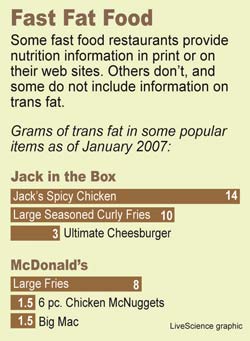Fat Facts: What's in Your Food?
Fat is an essential part of a balanced diet. But saturated fat should be consumed cautiously.
Trans fat is insidiously unhealthy and should not be consumed at all. Health experts say it increases the risk of heart disease, among other ills.
Yet trans fats are ubiquitous in the typical American diet, at least among those who eat in restaurants or consume highly processed foods. Trans fats are not confined to french fries and burgers. They show up in potato chips, donuts, cookies and cakes and even in fried foods and deserts served at many of the finest restaurants.
There are three types of fat:
Unsaturated fat: The healthiest. Liquid at room temperature. The USDA says a good diet should include these fats, which come from fish, nuts and vegetable oils, to provide essential fatty acids and vitamin E.
Saturated fat: Not as healthy. Solid at room temperature. Comes mostly from meat or dairy products and does contain some good nutrients. The USDA recommends limited intake.
Trans fat: Very bad for you (see below). Has an altered chemical structure to make it cheap and give food longer shelf life. Has no nutrients.
Get the world’s most fascinating discoveries delivered straight to your inbox.
A typical adult should consume the equivalent of 5-6 teaspoons of oil a day, or around 60 grams. Only about 20 grams of that should be saturated fat. And be warned: The FDA food-labeling law allows levels less than 0.5 grams per serving of trans fat to be called "trans fat free."
Saturated fat from meat and dairy products has long been known to raise levels of LDL, or bad cholesterol. But at least this type of natural fat contains nutrients.
Trans fat is a product of partially hydrogenated vegetable oil, which is oil injected with hydrogen and catalysts like platinum or palladium to change chemical bonds, giving "food products" a longer shelf life. Trans fat can be found in vegetable shortenings, some margarine (the hard variety) and some cookies, crackers, snack food, fried foods, doughnuts, pastries and baked goods.
Trans fat raises LDL, but it also lowers the level of HDL, the good cholesterol, causing the arteries to become clogged.
"Trans fat is a double whammy," says Alice Lichtenstein, a professor of nutrition science at Tufts University. "There is no biological need for trans fat and intake is associated with adverse health outcomes."
As of early 2007, most fast food restaurants and many sit-down restaurants used trans fat in their fried foods and baked good. It is cheaper than other, less-expensive options for cooking oils. Palm oil, for example, contains no trans fat and is about 50 percent saturated fat. Non-hydrogenated soybean oil has no trans fat and just 16 percent saturated fat.
In December 2006, New York passed a law that will phase out trans fat in all restaurants. Other cities are considering following suit, Lichtenstein said. Starbucks announced in January 2007 that it will begin removing trans fat from doughnuts, muffins and other treats.
But as trans fat is gradually eliminated from groceries and restaurants, Lichtenstein worries that American diets won't improve that much.
"In general, people are still eating far more saturated fat than trans fat," she said. "And the big giant—total calories—is always looming in the background."
Robert is an independent health and science journalist and writer based in Phoenix, Arizona. He is a former editor-in-chief of Live Science with over 20 years of experience as a reporter and editor. He has worked on websites such as Space.com and Tom's Guide, and is a contributor on Medium, covering how we age and how to optimize the mind and body through time. He has a journalism degree from Humboldt State University in California.




